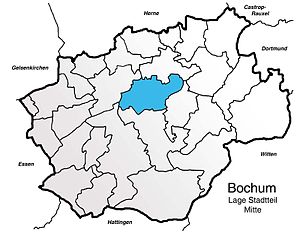Bochum city center
|
Bochum city center district of Bochum |
|
|---|---|
| Coordinates | 51 ° 28 '55 " N , 7 ° 12' 58" E |
| Residents | 42,288 (Dec. 31, 2019) |
| Post Code | 44787 |
| district | center |
| Source: | |
The district Bochum-City is located in the center of Bochum and in the district Bochum-Mitte . It is also called Bochum City by the city .
The city center is mostly located between the tracks of the Deutsche Bahn, which go to the main station , the north freight station or the Bochumer Verein station . Because the railway lines are built on elevated embankments, the border looks like a city wall and the entrances under the 17 bridges like city gates. The inner area of the city is also surrounded by the city ring (part of the B 226 ), a collection of mostly two-lane streets (north, west, south and east ring ) and an important traffic artery in Bochum. Numerous multi-storey car parks and underground garages offer a total of 4,600 parking spaces. The city center is very easy to reach by public transport, three underground lines alone meet at the main station. The lines of the light rail , like all buses in the city, are operated by the Bogestra .
There are many shopping streets in the city center; opposite the main train station, these are also a pedestrian zone. The longest is Kortumstrasse, on which the former Kortum department store and the “Drehscheibe” and “City-Point” shopping centers are located. Events take place regularly on the streets and squares, for example the Christmas market, the Bochum-Total music festival or Bochum culinary on Bongardsstraße. At the southern end of the pedestrian zone is the Bermuda3eck , a quarter with a high density of restaurants. The old Rietkötter brewery and the Moritz Fiege private brewery are both historical and modern sites of the art of brewing.
Many municipal and official institutions can be found in the city center, including municipal ones such as the town hall , the city library or the music school , judicial buildings such as the labor and regional court or others such as the Chamber of Industry and Commerce in the Middle Ruhr Area or the Bochum public utility .
In addition, various service providers have settled in the city center. There is a specialist center in the Europahaus . The Sparkasse Bochum and the Westfalenbank have their headquarters in the city.
The red light district on the streets Im Winkel / Gußstahlstraße , colloquially also known as Eierberg , is located in the west on the border with the Bochumer Verein. The “Madonna” association, supported by the city, North Rhine-Westphalia and the EU, has an advice center there.
There are only a few and small residential areas, including on Brückstrasse in the north and around Springerplatz in the south-west.
Important churches in the city center are the Catholic and oldest church in Bochum, the provost church of St. Peter and Paul , the Protestant Pauluskirche and Christ Church - the latter no longer used for church services, but for cultural events - as well as the Catholic St. Mary's Church, profaned in 2006 . The latter was used from 2007 to the end of 2012 as a rehearsal room by Urbanatix , a street art project that occurs every year in the Jahrhunderthalle. On October 28, 2016, the Anneliese Brost Musikforum Ruhr was opened on the adjacent square, including the former church building .
The West Park with the Centennial Hall is an important green area and cultural center in the west of downtown.
population
On December 31, 2019, 42,288 residents lived in downtown Bochum. This is divided into the statistical districts of Gleisdreick, Südinnenstadt and Kruppwerke.
Structural data of the population in the statistical district Gleisdreick:
- Population: 9,316 (2019)
- Minor quota: 10.9% [Bochum average: 14.6% (2019)]
- Old age quota (60 years and older): 19.6% [Bochum average 28.3% (2019)]
- Proportion of foreigners: 26.5% [Bochum average 14.4% (2019)]
Structural data of the population in the statistical district Südinnenstadt:
- Population: 17,370 (2019)
- Minor quota: 10.6% [Bochum average: 14.6% (2019)]
- Old age rate (60 years and older): 24.1% [Bochum average 28.3% (2019)]
- Proportion of foreigners: 9.9% [Bochum average 14.4% (2019)]
Structural data of the population in the statistical district of Kruppwerke:
- Population: 15,602 (2019)
- Minor quota: 16.6% [Bochum average: 14.6% (2019)]
- Old age quota (60 years and older): 19.5% [Bochum average 28.3% (2019)]
- Proportion of foreigners: 30.6% [Bochum average 14.4% (2019)]
Individual evidence
- ↑ Statistical data (population), based on the following source: City of Bochum - Department of Statistics and Impact Controlling: BOStatIS Bochum Statistical Information System: Topic: Population; Designation: "Population by age group and gender (population entitled to reside) " at: https://duvatools.bochum.de/asw/asw.exe?aw=/EWO_JB5AG_StaBez_2019_Geschl_tbl.ini (accessed on April 8, 2020)
- ↑ The population figures refer to all inner-city statistical districts (Gleisdreick, Südinnenstadt, Kruppwerke)
- ^ City of Bochum: Bochum-City ( Memento from February 17, 2013 in the web archive archive.today )


